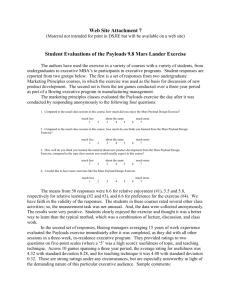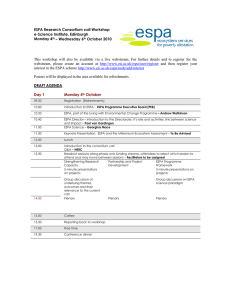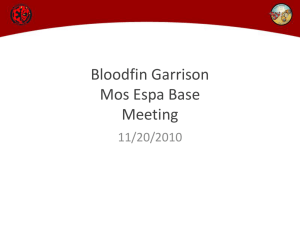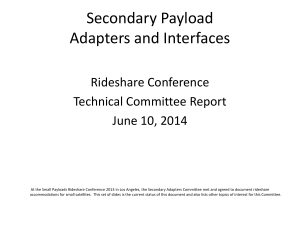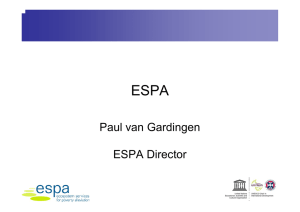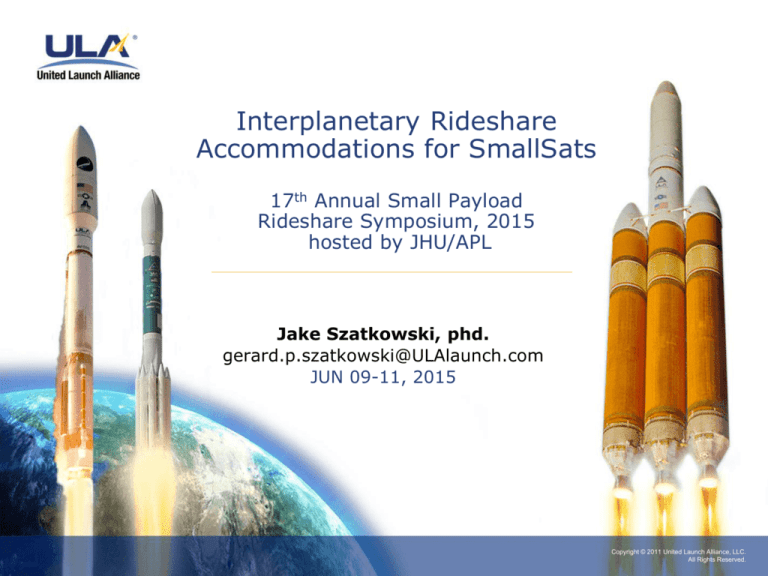
Interplanetary Rideshare
Accommodations for SmallSats
17th Annual Small Payload
Rideshare Symposium, 2015
hosted by JHU/APL
Jake Szatkowski, phd.
gerard.p.szatkowski@ULAlaunch.com
JUN 09-11, 2015
Copyright © 2011 United Launch Alliance, LLC.
All Rights Reserved.
Rideshare Spectrum of Capabilities
4
A range of capabilities address differing size, mass, and other
Requirements, while providing individual operational advantages
o
2
1
3
P-Pod
ABC
CAP
ESPA*
IPC / A-Deck
Poly PicoSat Orbital
Deployer
Aft Bulkhead Carrier
C-Adapter Platform
EELV Secondary P/L Adapter
Integrated Payload Carrier
10 kg
80 kg
100 kg
200 kg/ea.
500+kg
5000 kg
R&D Development
Releasable in LEO
2-4 Slots per Launch
Mix and Match H/W
Internal and External P/L
All Flight Proven H/W
Dynamically
Insignificant
Isolated from
Primary S/C
STP-1 Flew 2007
SP to 60 in. diameter
Sp to 100 in diam.
SERB List from the
DoD Space Test Program
Last Flight LRO/LCROSS
CDR 4Q 2009
ILC 2011
First flight
ILC 2011
First flight
ILC 2010
Less obtrusive than ESPA
First flight
Fist Flight 2010
ESPA Way Fwd Progress
DSS
Dual Satellite System
Delivering a Wide Range of Small Spacecraft with the Appropriate
Conops and Technical Accommodations
| 1
1 ESPA Graphic courtesy of CSA Engineering, Inc
2 COTSAT courtesy of NASA/AMES
3 NPSCuL courtesy of NPS
4 A-Deck courtesy of Adaptive Launch Solutions
NPSCuL Missions
picking up the pace for Rideshare
L-36/OUTSat Launched SEP 2012 (first-flight)
L-39/GEMSat Launched DEC 2013
Next: L-55/GRACE, AFSPC-5/ULTRASat in CY15
Photos courtesy Maj. Wilcox NRO/OSL
| 2
C-Adapter Platform (CAP)
CAP+
C-Adapter Platform (CAP)
Description
A cantilevered platform attached to the
side of a C-adapter to accommodate
secondary payloads
Vehicle
Atlas V, Delta IV
Capacity
4 CAPs per C-adapter
Interface
8-in Clampband
Mass
90 kg (200 lb)
Volume
23 cm x 31 cm x 33 cm
(9 in x 12 in x 13 in)
Status
First launch TBD
The CAP was originally
designed to accommodate
batteries that are part of the
Atlas V extended-mission kit
hardware
Payload
(Notional)
C-29 Adapter
| 3
CAP
ESPA Ring
EELV Secondary Payload Adapter (ESPA)
Description
An adapter located between the secondstage and the primary payload, which
can accommodate up to six secondary
payloads
Vehicle
Atlas V, Delta IV
Capacity
6 payloads per ESPA
Interface
15-in Bolted Interface
Mass
181 kg (400 lb)
Volume
61 cm x 71 cm x 96 cm
(24 in x 28 in x 38 in)
Status
Operational; first launch 03-2007 on
STP-1
Developer
Moog CSA Engineering
ESPA
15-inch bolted
interface (Six
places)
(Joe Maly, jmaly@csaengineering.com)
ESPA hardware will be used to
launch a rideshare mission in
2014, and additional missions
are being evaluated
| 4
Atlas V Centaur
Second-Stage
Forward Adapter
Payload
envelope
(x 6)
ESPA Grande Class
Mass
| 5
360 kg (800 lb)
AQUILA
AQUILA
Description
A flat deck and cylindrical spacers,
located between the forward-end of the
second stage and the primary payload
Vehicle
Atlas V, Delta IV
Capacity
Multiple payloads per AQUILA
Interface
Variable
Mass
1,000 kg (2,200 lb)
Volume
142-cm dia. (56-in dia.) x 152 cm (60 in)
Status
In development; CDR 04-2012
Developer
Adaptive Launch Solutions (ALS)
(Jack Rubidoux, jrubidoux@adaptivelaunch.com)
Graphics courtesy of ALS
AQUILA modular adapters are
rated to support a primary
payload mass up to 6,350 kg
(14,000 lb)
Payload
Adapter
(Notional)
RUAG
1575S
Separation
Ring System
ESPA
EELV Deck
Adapter (EDA)
A-Deck
C-Adapter
| 6
AQUILA
(Tall
configuration)
Separating ESPA
Lunar CRater Observation and Sensing Satellite LCROSS
Separating ESPA
Description
A separating rideshare payload that
uses the ESPA ring as the structural bus
of the satellite
Vehicle
Atlas V, Delta IV
Capacity
Variable
Interface
62-in Bolted Interface
Mass
1,360 kg (3,000 lb)
Volume
350-cm dia. x 61 cm
(138-in dia. x 24 in)
Status
Operational; first launch 06-2009 on
LRO/LCROSS
Developer
ESPA
62-in
Separation Ring
ESPA
Moog CSA Engineering
(Joe Maly, jmaly@csaengineering.com)
A separating ESPA can use
various separation ring
hardware solutions from a
number of vendors to separate
from the ULA launch vehicle
LCROSS
| 7
MULE Third Stage
(Multi-payload Utility Lite Electric)
MULE stage provides high deltaV to perform delivery of ESPA
class payloads to a variety of orbits and Earth Escape missions
– Delivery to Earth Escape (Lunar, NEO, Mars)
– Delivery of a constellation (3 ESPA S/C)
– Solar Electric propulsion
– 10 m/s delta-V
– Laser comm or high-gain antenna
– On-orbit operations multi-yr
– Potential to add another ESPA
Co-sponsors:
– Busek Space Propulsion
(Hall Thrusters)
– Adaptive Launch Solutions
– Oakman Aerospace
(S/C Integration)
(Avionics)
Specs: 1400 kg wet mass w/o payloads
2400 kg wet w/ (4) 180 kg payloads
| 8
ULA Patent
Mission Concept
Solar panels deployed
carrier begins the journey
to Mars
SmallSats are
deployed after
entering Mars orbit
After primary sep
Rideshare carrier sep
from second stage
Rideshare payload
w/ Polar or GTO
mission
Launch
The MULE using lite-electric propulsion
can deliver: (27) – 3U CubeSats or
(3) – SmallSats to Mars.
| 9
Mars “TDRSS-lite” Delivery
Con-Ops
Earth
comm-link
Rideshare Earth escape
MULE Mars Rendezvous
Deploy ea free-flyer s/c
Move MULE to high orbit
Deploy High-gain antenna
Mars
Operations
Mother-ship moves to L1 position
MULE Stage switches power to high-gain
Permits comm links:
– Surface to Surface
– Surface to Earth
– Continuous surface observation
– Internet-like service
| 10
Mother-ship
ASO orbit
7000 km orbit
S/C-2
Mars
S/C-3
S/C-1
Thruster Performance and Delta-V Comparison
Column
Gas
z
ag
Column
ah
ai z
FlowIodine
Rate Potential Current
Gas
Power
Flow Rate
(mg/s)
(V)
(A)
(W)
(mg/s)
I2
1.02
151
1.02
I2
155
1.02
Xe
0.99
152
1.03
Xe
156
0.99
I2
1.02
202
1.05
I2
211
1.02
Xe
0.99
202
1.01
Xe
203
0.99
Xenon
I2
0.62
251
0.53
I2
133
0.62
Xe
0.58
252
0.53
Xe
134
0.58
I2
0.82
251
0.74
I2
187
0.82
Xe BHT-200
0.78
252
0.76
Xe
193
0.78
I2
0.85
302
0.81
I2
245
0.85
Table indicate
that
drop-in
Xe
0.78 iodine
302 is a 0.76
Xe
231
0.78
I2
1.02
1.04
I2
368
1.02
replacement
for
xenon.353
Xe
1.04 has the
353 potential
1.13
Xe to yield
400
1.04
It’s high storage
density
a
significant increase in spacecraft delta-V, when
propellant volume is restricted. This is illustrated by
using the rocket equation and assuming a fixed
propellant volume and dry mass. With iodine (Table
1) the delta-V increases by a factor of 2.4 with
respect to Xe allowing the iodine fueled MULE to take
payloads from GTO/Polar to Mars, Venus, or an
Asteroid, using low-pressure, conformal, composite
fuel tanks.
| 11
j ag
au ah
az ai
be j
bj au
Thrust
Potential T/P
CurrentAnode
Power
Isp Anode
Thrust
Eff
K T/P
(mN)(V) (mN/kW)
(A)
(s)(W)
(-)(mN) (mg/C)
(mN/kW)
11.1151
711.02 1110
155
0.3911.1
0.9971
11.2152
721.03 1151
156
0.4111.2
0.9672
14.3202
681.05 1436
211
0.4814.3
0.9768
13.5202
671.01 1394
203
0.4613.5
0.9867
8.3251
620.53 1350
133
0.418.3
1.1862
8.0252
600.53 1409
134
0.418.0
1.0960
12.1251
650.74 1506
187
0.4812.1
1.1165
11.9252
620.76 1544
193
0.4711.9
1.0262
14.4302
590.81 1738
245
0.5014.4
1.0459
Gas
Units
Iodine
Xenon
13.4302
580.76 1750
231
0.5013.4
1.0258
Storage Density
g/cc
4.9
1.6
20.0353
541.04 1996
368
0.5320.0
0.9854
Specific Impulse
S
1909
1882
19.4353
481.13 1906
400
0.4519.4
0.9148
Propellant Mass
Kg
1225
400
Dry Mass of a typical S/C for
1500 W HET
Kg
1300
1300
Final Mass / Initial Mass
-
0.51
0.76
Delta-V
Km/s
12.4
5.0
Future Interplanetary Missions
Example mission: DMSP-19 (flew APR 2014)
S/C wt 2559 lbs
Atlas 401 (4m fairing, no solids)
Single injection burn 460 NM circular polar
Disposal burn to Earth Escape
Un-used performance to a C3 of 0 > ~3000 lb (1360 kg)
Addition of 1 solid (+1900 kg performance)
Would have enable Mars MULE mission w/ 3 ESPA payloads
Potential missions for Rideshare?
| 12
WR
ER
(protected dates )
WV
(CY16)
DMSP
(ILC CY17-18)
LDCM
(CY19)
Weather FO
(CY21)
GPS IIF
(CY16)
GEO
(CY17)
TDRS
(CY18)
GEO
(CY20)
MULE System Architecture
Flt-proven, Fault tolerant, RAD hard avionics suite
ESPA-Class Spacecraft accommodations
Reaction Wheels
/ Torquer Rods
Moog
Star Tracker
MST
Inertial Measurement Unit
(IMU)
LS200 IMU, Northrop
Flight Controller (RAD hard)
Command & Data Unit
Spacecraft #1
S/C
Services
Space Micro
DesignNet
DesignNet
S Band
Omni
antenna
Space Micro
Space Tracking and Data
Network (STDN)
Transponder
Battery, Yardney
HET Busek
Space Micro
RF Antenna
(Ka/Ku band)
Solar Arrays
First RF
Sierra Nevada
| 13
Spacecraft #3
Spacecraft #4
Power
Management
Busek
FastCap
Spacecraft #2
Avionics Functional Diagram
| 14
100 KW High Power System
ULA 100 KW array stowed config.
CFLR Deck
Stowed Wing
Busek 20-kW Thruster at GRC VF5
Patent pending
| 15
Cluster of Busek Xe HETs
1-kW Iodine Plume
What does it mean for Interplanetary Missions?
Some of our missions (particularly polar ones) do Earth-escape
disposal of the upper stage
Some of the missions have fairly large margins
It is possible to add up to 5 solids boosters (1000 lbs margin ea)
It is possible to raise the apogee to beyond L1 for a separation
The primary will dictate the time of launch and the moon can be
anywhere in its orbit.
However, if a Lunar exploration s/c could loiter long enough it could
sync with and be captured by Lunar gravity
ULA can work to help broker rideshares with primary customers
ULA can assist for specific mission applications
ULA can assist in schedule/milestone planning
New R&D developments are in-work
– New disposal techniques that add margin coming on-line
– New heavy solar array system
– New extended mission systems
| 16
Adding Performance via SRM’s
ULA's Atlas V and Delta IV launch vehicles have multiple configurations
based on the number of solid rocket motors (SRMs) flown
For both current missions, or when designing a new rideshare mission,
the addition of an SRM can provide an appreciable amount of mass
capability to orbit, as shown below
All values are in kg
ORBIT
VEHICLE
Atlas V 4-m
GTO
(35,786 X 185 km @ 27.0 deg)
Atlas V 5-m
Delta IV 4-m
0 SRMs
1 SRM
2 SRMs
3 SRMs
4 SRMs
5 SRMs
4,750
3,780
4,210
+ 1,200
5,950
+ 1,470
5,250
+ 940
6,890
+ 1,230
6,480
6,160
+ 1,950
5,080
+ 1,160
11,140
+ 2,100
11,160
+ 2,840
10,530
9,610
+ 810
7,700
+ 970
7,450
+ 840
8,290
+ 610
8,900
Delta IV 5-m
Atlas V 4-m
LEO Polar
(200 km circular @ 90 deg)
Atlas V 5-m
Delta IV 4-m
Delta IV 5-m
| 17
8,080
6,770
7,690
+ 1,900
9,980
+ 2,200
9,060
+ 1,810
6,890
+ 990
12,130
+ 1,720
12,880
+ 1,600
14,480
+ 1,990
11,600
+ 1,280
15,760
MULE Rough Specs Summary
MULE stage built on ESPA ring and standard ULA separation system
Total mass of the MULE stage with 14,055lb SV is ~19,500lb
~5kW solar array
4 of Busek 1.5kW thrusters on 2 gimbals
GTO to GEO transit time <140 days
Mars transit 3 years
ULA has been working w/ Busek Propulsion on the Hall Effect thruster
– Xenon
Isp = 1544 for Xe at 250 V, 200 W
– Iodine
Isp = 1506 for I2 at 250 V, 200 W
Iodine solution launches as a solid in lite-wt composite tank and
sublimates with a low power heater, thus
eliminating the need for heavy pressurized tanks
Minimum delivery time first unit ~3 years
EP Upper stage first-flight cost (including NRE) ~$50M
Re-flight unit ~$35M
No significant technical challenge
| 18



